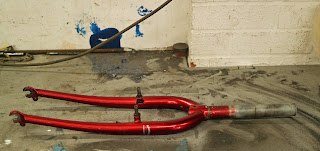Another 120 miles on my tubby tourer, pleased with the recent revisions, I decided it was time to dial in the Genetic CX cantilevers. There was a little too much lever travel, for my tastes. Thankfully, they’re much easier to hone, than the otherwise impressive IRD CAFAM2. Pull cable and straddle wires through a few mm, tweak balance screws-Result!
Switched to The Muc-Off Dry Lube, since opportunity presented. A freshly cleaned and lubricated chain always makes the drivetrain feel that bit fresher. However, 100 miles or so later, I'm increasingly forming the opinion that friction is lower than the Zefal Pro Dry Chain Lube https://www.sevendaycyclist.
Shifting feels almost instantaneous, in both directions across the block, even under load. The pronounced lack of friction just encouraged me to increase my temp. I’ve also concluded gearing is bang on, for the riding contexts intended.
Admittedly, I could go slightly lower, for heavier trailer loads, but for time being I’ll leave be. Durability is another consideration (especially given the Muc-Off Dry Lube’s relatively long curing period).
However, I’ve gone past the 160-mile stage without any hint of waning. In common with some wax formulas, several days at 23-28 degrees, and its assumed that fluid consistency. Lubricant has seeped deep within the chain, and a filmy, residual layer is clinging to the cassette. It’s also quite tacky to touch, though transfer to fingers/clothing hasn’t proved overly problematic, thus far.
For some folks, the lube debate is binary i.e. if you’re riding in wet/changeable weather, stick to a wet formula. Dry, for arid, dusty conditions. However, given the UK’s notoriously changeable climate, I like something that can bridge the gap, resisting those unpredictable showery periods, without attracting a gungy beard.
That said and testing aside; chances are you’ll find my chains running a stoical wet formula, such as Weldtite TF2 Extreme wet chain lube https://www.sevendaycyclist.
This might look unsightly but is “embalming” the chain. Crap eventually flakes away in chunks, leaving only a layer of lubricant behind. Here’s an overview to lubes, if you’re new to riding, or want to explore the best option(s), for you. https://www.sevendaycyclist.
Elsewhere, I’m also warming to the Oxford Contour flow saddle. 120 mixed terrain miles in, the relatively narrow profile and sensibly proportioned padding density are proving a winner for my derriere. I was slightly surprised to discover the rails are a solid steel, which would probably explain the weight differential, compared with those sporting hollow Cro-moly.
4130 is common at this price point too, and my preference.
Is it a deal breaker? Not necessarily, why bemoan a few grams, if the saddle fits your shape and goes unnoticed, in the most positive sense. Will give it another 250 miles before reaching a conclusive verdict, mind.
Those seeking a wallet friendly 6061 post, with classic lines might be interested in Steve’s review of the Genetic Heritage II sea tposthttps://www.sevendaycyclist.



















































